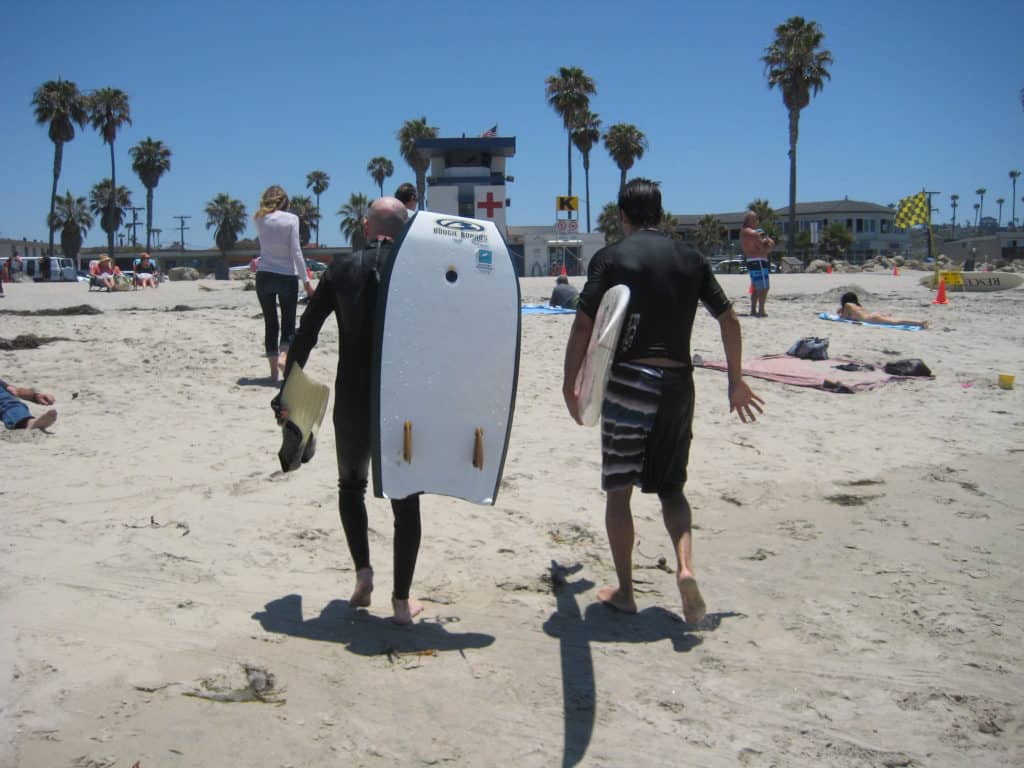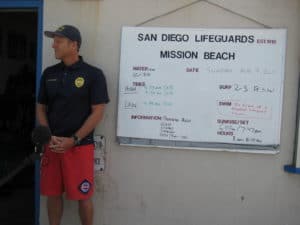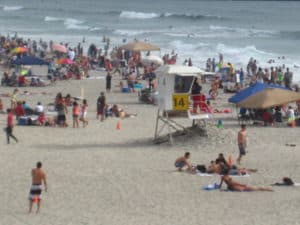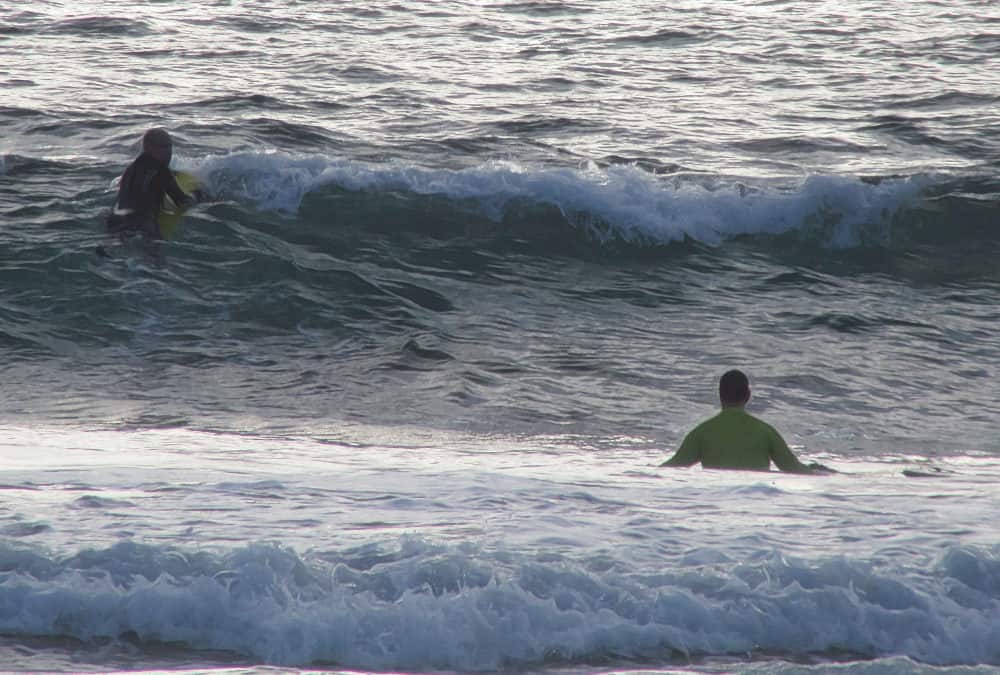Body Boarding San Diego
 San Diego with its white sandy beaches, world-class waves and long summer season, is a surfer’s paradise where consistent reports of “Great surf, Dude!” (or “Dudette!”) are music to any body boarder’s ears. And body boarding in San Diego is something locals love to do when summer time rolls around. Body boarding San Diego is also something most newbies can learn to do in one or more surfing sessions.
San Diego with its white sandy beaches, world-class waves and long summer season, is a surfer’s paradise where consistent reports of “Great surf, Dude!” (or “Dudette!”) are music to any body boarder’s ears. And body boarding in San Diego is something locals love to do when summer time rolls around. Body boarding San Diego is also something most newbies can learn to do in one or more surfing sessions.
What is Bodyboarding? It’s a sport in which people of all sizes can have fun in waves of all sizes. Want to try it? This is your guide to Bodyboarding equipment, techniques and safety tips with a round-up of San Diego’s best surf sites.
WHY DO WE DO IT?
Tom Morey, who in 1971 trademarked the first “Boogie-board,” put it like this: “When I caught that first wave, I could feel the wave itself, every contour and change beneath me. What silent personal joy those first few waves… like no other feeling.”
Other advantages? You don’t need a car rack or wood-paneled station wagon to transport your bodyboard. You can stuff it into the trunk of your car, or carry it in a backpack, on bike or on foot. While surfers shun the smaller, irregular waves, bodyboarders can still squeeze out lots of fun with something surfers can’t use: a pair of fins. For a minimal financial outlay–bodyboard, leash, wetsuit and fins–you can enter the sport. That’s it. You won’t have to pay exorbitant lift, trail-use, or national-park fees. The ocean is free.
EQUIPMENT
Boards
Whether it’s a “Boogie,” “Invader” or “Death Star,” get yourself a foam board that makes you happy and take it out for a dance in the waves. Bad Boy, Custom X, Manta, Toobs and others manufacture many different sizes, styles and colors of the foam boards, available at surf shops. I’ve even seen bodyboards at Costco. Consider shape, size, weight and wave conditions. You’ll end up spending anywhere between $50 and $250 for the board of your choice. In selecting a proper fit, basically, for most people, the up-ended board should reach your navel. The heavier the rider, the thicker and wider the board should be for better flotation.
Bodyboard covers are available for storage and/or transport, ranging in material from basic toweling to heavy-duty padded nylon with backpack straps and compartments.
Leashes
A leash is necessary, if you want to avoid trips to the beach to retrieve an errant board. The coiled wrist leash with a swivel and neoprene-padded wrist strap for comfort is most popular.
Fins
Fins can make the difference in catching a wave. When you purchase your pair, make sure they fit just snugly enough. A wave can snatch a loose fin right off your foot and send you on a merry chase. Fins too tight can cause blisters and cramps. Several brands are available, so if one kind doesn’t fit perfectly, try another. The most popular fins are short with wide blades, an open sole and back strap. For around $10 you can get fin tethers that wrap around your ankle and the back of the fin. Wearing a thin pair of socks with your fins will help prevent chafing and blisters. They can keep your feet just that much warmer, and ensure snugly-fitting fins.
Wetsuits
Even at the height of summer, when the water temperature reaches 70+ degrees, you may want protection from both the sun and the ticklish touch of the long-fingered kelp that fringes many of our surf sites. Your toasty suit will enable you to stay out for long surf sessions. You’ll see plenty of bodyboarders without wetsuits, but eventually they get cold and ride back to the beach long before the seal-skinned enthusiasts do.
When shopping for a wetsuit, remember that the thicker the neoprene material, the more buoyant you will be, and more susceptible to where the waves and currents have a mind to carry you.
Equipment Maintenance
Increase the longevity of your equipment by storing it out of the sun, rinsing it with fresh water after every use and avoid drying in direct sunlight. Don’t lean your board against sharp objects, or drag it on the beach, as the foam or slick bottom can be easily damaged. Store it on its nose rather than on its end, since folds or dents on the aft can affect performance.
SAFETY TIPS
 Our friendly San Diego lifeguards offer the following safety tips:
Our friendly San Diego lifeguards offer the following safety tips:
- · Be aware of ocean conditions prior to entering the water.
- · Bodyboards are not safety flotation devices. Know how to swim.
- · Swim near a lifeguard.
- · Never swim alone.
- · Supervise children closely, even when lifeguards are present.
- · You may be able to spot any rip currents. Look for a muddy flow moving away from shore. If caught in a rip current, swim sideways until free. Don’t swim against the current’s pull.
- · Alcohol and swimming don’t mix.
- · Protect your head, neck and spine. Don’t dive into unfamiliar waters. Jump feet first.
- · If you feel you are in trouble, don’t be shy, call or wave for help.
- · Follow regulations and lifeguard directions.
- · Report hazardous conditions to lifeguards or other beach management personnel.
SURF ETIQUETTE
If it’s your first time, it’s a good idea to spend time watching the way other “spongers” catch waves. You’ll notice that they aim themselves at the middle, or highest point, of the wave, and then ride it to the left or the right, whichever way has the cleanest route. When you feel ready, go conquer yourself a wave. But before you do, know the rules. When you first paddle out, make yourself “scarce” to those who are already riding the waves so they don’t have to worry about dodging you. If two riders are paddling for the same wave the one on the “inside,” closest to the breaking section of the wave, gets it. If someone is already riding the wave you were paddling for, then you must bow out.
TECHNIQUES
Assessing the Waves
It’s wise to spend a few minutes checking out the waves before jumping in. You can discern the rhythm of the sets, how and where the waves are breaking, and how big they are. If the waves are big, you’ll want to wait for a lull between sets to venture out.
Paddling Out
Walk out to where the water is up to your waist and put on your fins. Position your board under you with your belly on the end of the board, and both hands gripping the front. Begin kicking evenly out into the ocean, legs stiff and fins submerged. When the board feels balanced beneath you, freestyle-paddle your arms. The bigger and faster the oncoming waves, the faster you should paddle and kick. Cupping your hands will give you that much more oomph to stroke forward. The object is to get out past the breaking waves.
Duckdiving
The best way to negotiate past the white water is to “duckdive.” When you see an impending wave about to curl over on you, just before it does, grab both front sides of your board, take a breath, push the board’s nose down below the oncoming water, and duck down. You will find that paddling out is where you’ll get your best workout. After you reach the calm area where waves are forming, and fellow bodyboarders may be bobbing, take a rest, and prepare to boogie!
Take-off
The moment you’ve been waiting for… Select a well-shaped wave, one that is not already “closing out,” spouting white water. Position yourself in the path of the wave’s peak. You should already know if you want to head left or right, whichever way the wave is breaking better. Begin kicking and paddling as fast as you can towards the beach. When you feel the wave lift you, shove your weight towards the front of the board, stop paddling and with both hands push the nose of the board down enough to send you off the wave’s lip, in your chosen direction. Hold on to the rails of the board. Rather than going forward with the white wash, try and traverse the face. This is how you can really milk out the “endless” rides, as long as the wave continues to grant a clear path. When the wave “washes out,” duckdive back through it and head past the breakers. Go catch a few more waves.
Wiping Out
Everyone’s been there, and your first time dropping “over the falls” for a trip in the “wash cycle” won’t be your last. First, don’t fight it. Make sure you take a big breath prior to going under. Stay calm, and let the wave spit you back to the surface. As you will discover, this inexpensive and easy-to-learn sport can provide hours of pleasure for you and your family. The more you practice, the more waves you’ll catch. Just don’t take it too seriously. Relax and have fun. Surf’s up!
BEACHES
Black’s Beach
This two-mile sandy strip lies below 300-foot cliffs at the top of which is a glider port. You must climb down treacherous, eroding trails to reach the excellent surf. The safest access is at low tide from north and south adjacent beaches. You should be aware that Black’s is world-famous for its nude sunbathing. Directions: I-5 South to Carmel Valley Road; west to Pacific Coast Highway; south to Torrey Pines State Beach. Beach access a mile south. I-5 North to Ardath Road. Go right at La Jolla Shores Drive then left on Calle Frescota to free public parking lot at La Jolla Shores. Beach access a mile north.
La Jolla Shores
This mile-long sandy beach features the gentlest break in San Diego. It’s a forgiving learning ground for bodyboarding. If you go, consider taking snorkel or scuba gear to enjoy the La Jolla Ecological Reserve sea life. Directions: I-5 South to La Jolla Village Drive west, left at Torrey Pines Road to La Jolla Shores Drive. I-5 North to Ardath Road, right at La Jolla Shores Drive, left at Avenida de la Playa, right on Camino del Oro.
“The Strand:” South Mission, Mission & Pacific Beaches
 The highly-popular two-mile stretch of sand is subdivided into South Mission Beach north of the Mission Bay channel entrance; Mission Beach which centers at the rollercoaster; and Pacific Beach, south of Crystal Pier. Look for the designated surfing areas. This beach is dotted with lifeguard stations. On the boardwalk you’ll find public restrooms and showers, beach rental shops and restaurants.
The highly-popular two-mile stretch of sand is subdivided into South Mission Beach north of the Mission Bay channel entrance; Mission Beach which centers at the rollercoaster; and Pacific Beach, south of Crystal Pier. Look for the designated surfing areas. This beach is dotted with lifeguard stations. On the boardwalk you’ll find public restrooms and showers, beach rental shops and restaurants.
Directions: South Mission: I-5 to Sea World Drive, to West Mission Bay Drive. Turn left on Mission Blvd. At the end turn right into the parking lot. Mission: I-5 to Grand Avenue. Turn left on Mission Boulevard. The beach is accessible from anywhere along the boulevard. Pacific: I -5 to Grand Avenue. Follow it west to the ocean.
Ocean Beach
This wide sand beach stretches a mile between the Ocean Beach Pier south, and Mission Bay channel entrance north. Public restrooms and showers are next to the main lifeguard station. Enjoy the bohemian flavor of the shops and restaurants on Newport Avenue.
Directions: I-8 West to the end. Left on Sunset Cliffs Boulevard, right at Santa Monica Avenue to the beach.








